A reed switch is used for the speed of response of the security, fire-prevention system, emergency notification and control systems. The element detects the state of the object, the appearance of smoke, dust, and prevents unauthorized access.
- What is a reed switch
- Design and appearance
- Reed switch classification
- Normal contact state
- Design
- Technical specifications
- Principle of operation
- Instrument parameters
- Advantages and disadvantages
- Reed switch connection
- Practical use in everyday life
- Use in security systems
- Strengthening protection against unauthorized entry
- Nuances of using reed switches
What is a reed switch
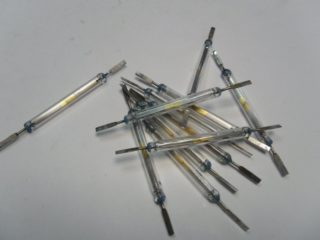
The reed switch sensor is an electromechanical type device. It can open and close contacts when exposed to a magnetic field created by an electric or permanent magnet.
The interpretation of the term is a sealed contact, which is determined by its design. The device consists of a pair of ferromagnetic plates sealed in a glass capsule. The reservoir is filled with inert gas, nitrogen, dried air and has two outlets. Such a bulb prevents external factors and increases the reliability of the device.
To increase the switching voltage, the shell is evacuated.
Design and appearance
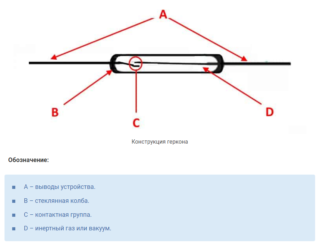
The appearance of the reed switch is a sealed glass bulb with magnetic core contacts. There is a gap between them. The elements are fixed by welding from the ends of the shell and connected to the network by external parts. The sensor itself looks like a float and consists of three parts:
- glass flask;
- changeover contact;
- fixed contact.
Thanks to the rectangular contacts made of ferromagnetic wire, the device can close the network. The type of coating of contact elements depends on the power and dimensions of the product. Manufacturers use gold, rhodium, silver or permalloy wire.
Inert gas sensors or vacuum versions will not corrode.
Reed switch classification

Reed switches are divided into types according to several criteria.
Normal contact state
Contacts are:
- closed - the circuit is opened by means of a magnetic field;
- switchable / bistable - one contact closes when the field is applied, the other - if it is not;
- open - the reed switch is triggered at the moment of the formation of a magnetic field.
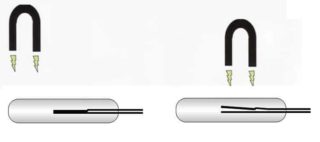
Changeover contact models have 3 pins.
Design
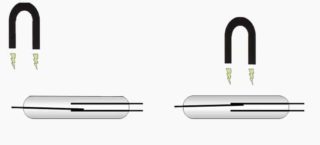
There are such sensors:
- sleeve - the glass shell is filled with inert gas or air;
- mercury - to improve switching, reduce resistance and eliminate vibrations, the contacts are covered with mercury.
Sleeve reed switches have dry contacts.
Technical specifications
Depending on the technical characteristics, there are:
- Hercotron is a high voltage insulated reed relay. Operates in a network with a voltage of 10-100 kV.
- Gazakon is a modification that remembers the position of the contacts after the magnetic field is turned off.
- Herksikon is a relay that activates alarms and equipment with a power of up to 3 kW. Differs in increased switching current and arcing contacts.
The devices can replace the electromechanical relay.
Principle of operation

The principle of operation of a reed switch is based on opening or closing the network, where it stands, under the influence of an electromagnetic field. The magnetic flux voltage determines the position of the contacts. The field is generated by a permanent or electric magnet.
The internal contacts of the device are magnetized at the moment they come under the action of the power line. The elements are attracted by an action that overcomes the elastic force. This is how the circuit closes. When the line is connected to a power source, current flows through the device.
This state lasts until the moment the influence of the force line ceases. The contacts open without a magnetic field. To re-closure, you will need to re-generate the field.
A reed switch is a small-sized switch that operates from the force of a magnetic flux.
Instrument parameters
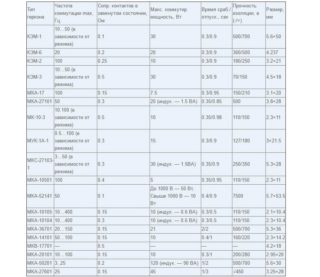
The type of equipment to which the magnetic reed switch belongs is relay. Before buying it, you should consider the following characteristics:
- Response time. Depends on the reaction time to the appearance of a magnetic field and does not exceed 2 μs.
- Magnetic field strength. Sensitivity depends on ferromagnet and size.
- Switching power. The limit of the energy transmitted through the reed switch, taking into account the material and cross-section of the contacts.
- Ultimate stress. Determines the amplitude of the shutter speed signal of the apparatus.
- Resistance of closed contacts. At a lower value, less signal power is lost.
- Permissible operating temperature. Depends on the manufacturer, but most often the element works at temperatures from -60 to +120 degrees.
- Frequency. Triggering occurs at a frequency of up to 1 MHz.
- The number of switching cycles. Determines the number of triggers.
- Contact capacity. Depends on the distance between the platforms in the open position.
- Physical dimensions. A horizontal balloon can be from 4 mm in length.
Contact capacity is a parasitic criterion.
Advantages and disadvantages
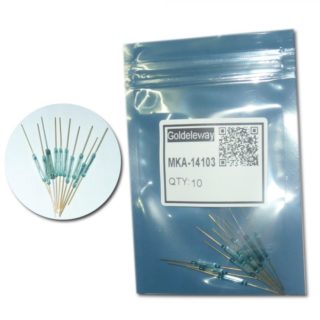
The positive factors of using reed switches include:
- no rattling for modifications with mercury outputs;
- reliability - the sensor will not break when dropped and exceeds the performance of a standard relay by 100 times;
- no risk of burning contacts located in a vacuum or inert gas;
- the small-sized sensor is designed for a current similar to a standard relay;
- presence of galvanic isolation - devices are connected to the network in series;
- switching of weak signals;
- a large number of inclusions without friction;
- operation without reference to the source of electricity.
The low cost of the devices is due to the absence of precious and refractory metals in the contacts.
The disadvantages of operating reed switches include:
- high weight in comparison with relays with open contacts;
- the need to generate a magnetic field;
- do not always withstand shocks and vibrations;
- the need for protection from external magnetic fields;
- the complexity of removing contacts from a closed state;
- limited response speed.
When exposed to a large current, spontaneous opening of contacts occurs.
Reed switch connection
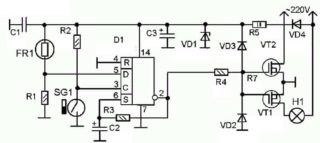
The float sensor is supplied with documentation regulating the connection process. They work step by step like this:
- The unit for creating a magnetic field is installed on the moving part.
- The reed switch is fixed on a fixed part of the structure.
- Closing the circuit. The movable part must adjoin tightly for the magnetic field of the coil to act on the contacts.
- Obtaining information about the correctness of the installation.
- Integrity violation notification. The coil stops acting on the reed switch.
The sensors can be installed hidden or externally on structures made of steel or magnetopassive type.
Practical use in everyday life
Reed switches are used to protect keyboard synthesizers and industrial installations from explosions, to increase the life of equipment. The parts control the mechanisms, and the float level sensor is needed to measure the liquid in the tank.
Reed switches are installed in television equipment, display the opening or closing of the doors. The devices are compatible with computer or security systems - they notify if a door or window is closed.
Electronic current meters have reed switches.
Use in security systems
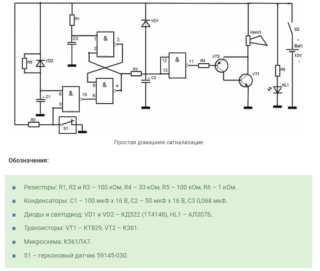
The peculiarity of the reed switch introduced into the security complex is its adaptation to the base material. This technique eliminates the influence of the magnetic field of the structure on the magnetic field required for the device to operate.
The sensor works on the principle of a magnetic latch. The switch is installed on the door frame, frame, and then a cable is connected to it. The open mounting method ensures the visibility of the device, but increases the magnetic field. For concealed installation, only sensitive versions that react to a magnet are suitable. Otherwise, there are risks of hacking.
Strengthening protection against unauthorized entry
As standard, the reed switch is on the frame and the magnet is on the door or window sash. The closed position of the structure ensures the maximum proximity of the magnet to the sensor. At the moment of opening, it is removed, so attackers can easily find the installation locations.
To increase the protection of the device, the following are used:
- Hidden device. Closes the signaling circuit at the moment the leaf is opened. The disadvantage of the technology is the opening of the sash using an additional magnet.
- Electric magnet. The peculiarity of the electromagnetic lock with a reed switch is the difficulty of counterfeiting due to the random repetition of signals. The protection is also triggered when the impulse is delayed.
An electromagnet needs a voltage of a certain duration.
Nuances of using reed switches
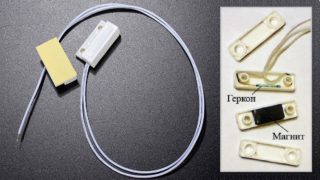
Before using or installing a reed switch, consider:
- The device is not compatible with ultrasound sources, because changes electrical parameters.
- The magnetic field affects the characteristics of the circuit breaker.
- On impact, the inert gas loosens, the cylinder may burst.
- The switch does not switch large currents due to the low power of the core.
Reed switches are not suitable for connecting powerful equipment.
The miniature reed switch is fast and is rated for 4-5 billion times. The device is compatible with the load of the low-voltage network and functions without reference to the source of electricity.








